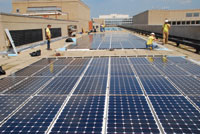 Today, the U.S. solar energy industry is poised for explosive growth and promises to become a significant contributor to the U.S. energy mix. The new Administration has signaled support for investing in a clean energy future and more legislation is expected to address climate change, mandate renewable energy requirements and improve our electric grid. The industry has attracted and created significant players that are all working to improve efficiencies and scale up manufacturing to bring down costs.
Today, the U.S. solar energy industry is poised for explosive growth and promises to become a significant contributor to the U.S. energy mix. The new Administration has signaled support for investing in a clean energy future and more legislation is expected to address climate change, mandate renewable energy requirements and improve our electric grid. The industry has attracted and created significant players that are all working to improve efficiencies and scale up manufacturing to bring down costs.
The Solar Energy Industries Association (SEIA), based in Washington, D.C., represents the sector with more than 850 member companies. We have learned over the last 35 years, since the trade group was first established, that with the right public policies, we can install more solar energy systems, attract billions in investment, build a clean energy industry, and add thousands of good-paying jobs.
In the last 3 years, we have seen exponential growth due in large part to the landmark 30-percent federal solar investment tax credit (ITC) that SEIA saw through passage in late 2005. The ITC, along with renewable portfolio standards passed by 19 states requiring a portion of energy come from solar or distributed renewable energy sources, has been a game-changer.
Growth in the Industry in 2008 SEIA’s U.S. Solar Industry Year in Review reported that total installed capacity grew 1,265 megawatts or 16 percent to 9,183 MW in 2008, up from 1,159 MW installed in 2007. Both photovoltaic and solar water heating systems grew at record rates, 81 percent and 50 percent respectively. And while no new concentrating solar power plants were completed in 2008, projects adding up to more than 7,000 MW are in the pipeline.
SEIA’s U.S. Solar Industry Year in Review reported that total installed capacity grew 1,265 megawatts or 16 percent to 9,183 MW in 2008, up from 1,159 MW installed in 2007. Both photovoltaic and solar water heating systems grew at record rates, 81 percent and 50 percent respectively. And while no new concentrating solar power plants were completed in 2008, projects adding up to more than 7,000 MW are in the pipeline.
The Emergency Economic Stabilization Act of 2008, passed on October 3, extended the 30 percent solar Investment Tax Credit (ITC) for eight more years, removed a $2,000 cap for residential photovoltaic (PV) installations, and now allows utilities to use the ITC.
However, the industry has not been immune to the global economic crisis. Many companies are having trouble getting enough credit; a few have announced significant layoffs. Support from institutional investors has weakened. Most expect to see more tempered growth and continued advancements in 2009.
Federal Policies to Spur More Growth
Provisions for renewable energy in the American Recovery and Reinvestment Act of 2009 made it the single most significant commitment to solar at the federal level in the United States. With 19 provisions in the bill that will directly affect the solar industry, SEIA estimates that a total of 110,000 jobs will be created through 2010. An analysis by Navigant Consulting, released in September 2008, estimated that the industry would create 440,000 permanent jobs by 2016 and attract $325 billion in investment as a result of extending the ITC for eight more years.
SEIA member task forces developed and submitted recommendations to the Administration for streamlined implementation of several new programs to stimulate investment. The renewable energy grant program provides a 30 percent direct grant in lieu of the solar tax credit as an alternative to investors. A new DOE loan guarantee program also supports financing of solar energy projects. The new 30 percent manufacturing tax credit provides strong incentive to companies for constructing new or expanded U.S. facilities that produce solar energy property or equipment.
Clear Signals from Obama for Investing in Renewable Energy
President Obama has been clear about his commitment to invest in and harness U.S. renewable energy resources. From his campaign stump speeches to his Inaugural address, he has declared goals to double our nation’s use of renewable energy by 2012 and have 25 percent of our energy come from renewable sources by 2025.
His choices in key cabinet officials and White House advisors are consistent with these goals. He has selected top-notch experts with the same commitment to protecting the environment, investing in research and using more renewable energy. It is notable that the top four advisors all come from California and New Jersey, the two strongest states for solar energy policy and installations.
Carol Browner, former head of the Environmental Protection Agency (EPA) is the White House Energy and Climate coordinator (the ‘Energy Czar’); Dr. Stephen Chu is secretary of the Department of Energy, a good fit with his credentials as a Nobel laureate and former head of DOE’s Lawrence Berkeley National Laboratory; Lisa Jackson leads EPA, bringing her experience as the head of New Jersey’s EPA; and Nancy Sutley, former Los Angeles deputy mayor for energy and environment, heads the White House Council on Environmental Quality. Also, the new Secretary of the Interior, Ken Salazar, is a long-time supporter of renewable energy.
Movement on Key Energy Policies
Leadership in the U.S. Congress bodes well for solar as well. Supporters include Senator Harry Reid (D-Nevada) and House Speaker Nancy Pelosi (D-8th, California). Senator Jeff Bingaman continues his role as chair of the Senate’s Energy & Natural Resources Committee; Congressman Henry Waxman (D- 30th, California) now chairs the House Committee on Energy and Commerce; and Congressman Edward Markey (D- 7th, Massachusetts) chairs the House subcommittee on Global Warming.
 Already we are seeing significant momentum on a number of key energy policies that are critical for solar, including a national renewable portfolio standard (RPS), expanding transmission infrastructure and climate change legislation.
Already we are seeing significant momentum on a number of key energy policies that are critical for solar, including a national renewable portfolio standard (RPS), expanding transmission infrastructure and climate change legislation.
More than half of the states in our country have renewable portfolio standards. Now there is consensus forming to enact a national RPS to meet the president’s goal of producing 25 percent of our electricity from renewable sources. The national policy should not preempt states with more aggressive goals and should ensure a diverse portfolio of sources deploy, including solar.
The United States is home to vast quantities of clean energy resources like solar power. Yet it lacks a modern interstate transmission grid to deliver carbon‐free electricity to customers in highly populated areas of the country. To meet our national climate, national policy should address long-term planning, cost allocation and recovery, and federal siting authority, to update and build a transmission grid that supports market demand.
Climate change legislation should distribute emissions allocations fairly, including credit for clean energy like solar, and reinvest a portion of auction proceeds in solar energy projects.
Emerging Mid-Atlantic Region
In March, New Jersey Governor Corzine flipped the switch on a new 2.3 MW array on top of the Atlantic City Convention Center. This is another significant announcement for the mid-Atlantic.
Most people are surprised to learn that New Jersey is second in the nation (after California) for installed solar PV. This is due primarily to the Garden State’s forward-looking policies and incentive programs. New Jersey has an RPS with a solar carve-out, as do Pennsylvania, Maryland, New York, and the District of Columbia. Mid-Atlantic legislative solar requirements will soon challenge California’s goal of 3 gigawatts of installed solar generation.
In fact, we selected Philadelphia as the site for our new PV America conference in June to highlight this important emerging region for solar. The conference, which moves to Tampa next year, presents the most current updates on policy, finance, PV technology, industry trends and business opportunities by leading PV experts in industry, research, government and academia. All proceeds of the event go toward advancing and expanding the U.S. solar industry market.
The Solar Power International conference co-hosted by SEIA and the Solar Electric Power Association is expected to attract more than 23,000 attendees from more than 70 countries in Anaheim, California, October 26 - 29. Despite a weak economy and uncertainty, the fall show has already sold two times the amount of exhibit space to more than 500 companies.
In the United States, support for renewable energy has reached unprecedented levels in politics and in business. Just like the sun, we need to capture it, convert that power and put it to work.


